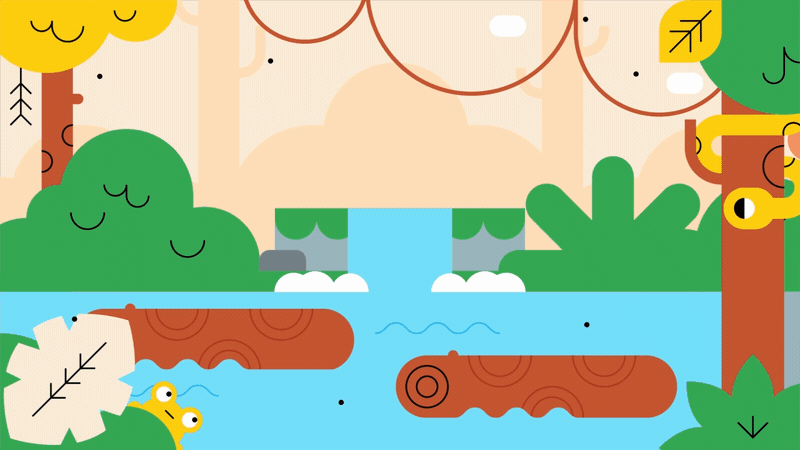
Rainforest rescue
You’ll need
- Masking tape
- Rope
- Chairs
- Newspaper
- Benches
- Carpet squares or doormats
Before you begin
- You can adapt this activity to use whatever equipment you have—be creative!
- Mark a start and finish line using masking tape (or chalk, or rope).
- Set out all of the obstacles with enough space in between, in this order:
- Rafts (two carpet squares for each team)
- Bridge (bench, chairs, blocks, or crates)
- Log (double sheet of newspaper)
- Fallen tree (bench, block, or crates)
- Snake (rope or skipping rope)
- Stones (two or three carpet squares or sheets of newspaper for each team)
- Why not use toy animals, dried leaves, or a rainforest soundtrack to set the scene and create an even more realistic rainforest experience?
Cross the Amazon
- Split into teams of four or five people.
- Everyone should pretend to get dressed for their Amazon adventure. They should pretend to put on strong boots with thick socks to keep out the scorpions. They should pretend to put on a backpack and tighten the straps, then pull on a hat. Make sure it’s nice and secure to protect you from falling spiders!
- Everyone should close their eyes, and get ready to magically transport to the Amazon rainforest. They should take a deep breath and pretend to feel the warm, damp, air, and the heat prickling their skin. Can they hear the howler monkeys in the trees above them? What about the sound of insects, or the faraway roar of a jaguar? They’ll have to work together to cross the final stretch of forest so they can get home—but the final stretch is the most dangerous of all.
- Everyone should open their eyes, and look around, pretending they’re in the rainforest. The first team should go to the starting line, and prepare to cross the Amazon. While they’re having their go, everyone else should watch carefully. They can shout encouragement, and plan their tactics in their team as they learn what works best.
- The team crossing the rainforest mustn’t touch the floor at any point. If they do, they’ll have to go back to the start. As they cross, the person leading the game may spot some other (pretend) dangers and shout instructions to keep everyone safe.
We’ve included some suggestions of dangers below.
- First, the team reaches a stream. There are piranhas in the water that’d love to nibble their toes, but thankfully someone’s left two rafts (carpet squares) to help them cross the stream and reach the bridge (chairs or bench). The team should use the rafts to move to the bridge.
The person leading the game can give hints and tips—everyone should squeeze onto the first raft and move the second a bit further ahead, then move on to it and pass the first raft ahead again, and so on.
- Thankfully the team avoid the piranhas and reach the bridge. They should cross the bridge.
- There’s a fallen tree up ahead, but the only way for the team to reach it without touching the bug-infested floor is one log (a double sheet of newspaper)! Someone should break the log in two, and use both halves to reach the tree. They should think about where they’ll break the log—it might be a bit trickier if one piece is tiny. Once they’ve snapped the log, they should use it just like the rafts, to cross the floor.
If the team ends up with uneven pieces they’ll have to work with it, but you may want to keep a few extra sheets as back up just in case.
- Once the team reach the tree, everyone should give them some much-needed encouragement! They’re almost there now. The team should cross the fallen tree.
- Hang on, what’s that? The team should freeze, because there’s a huge snake (rope) slithering towards them. They should use what’s left of the log (newspaper) to make something to push it away, but they’ll have to be slow and gentle so they don’t scare the snake—or make it angry. Someone should roll up the log (newspaper) to push the snake away.
If the team didn’t bring the newspaper over the bridge with them, someone may have to double back and collect it. This would be a great chance for the other teams to spot something they could do differently.
- Phew, the snake’s slithered away to find someone else for dinner. The team should check that everyone’s OK, then they should use the stepping stones (carpet squares or sheets of newspaper) to cross the last bit of the journey and reach safety.
- Once a team’s reached safety, everyone should celebrate. They should sit together, and the next team should repeat steps four to nine to cross the Amazon. The other teams should keep watching, offering encouragement and tips, and planning their tactics if they haven’t had a go yet. The team who’ve finished may have some especially useful hints!
- Keep playing until all of the teams have had a turn at crossing the Amazon. Everyone can sit back, relax, and feel proud of what they’ve done.
The person leading the game could add in one last surprise by waiting until the teams are relaxed then shouting one of the dangers to make them jump and laugh (but make sure you think about whether everyone in your group will find it funny first!).
Added dangers
It’s up to you how long the dangers last. If a team’s doing really well, why not combine them? It would be really tricky to brush the spiders off one another while crouching on one leg!
- ‘Oh dear! It’s raining—stop what you’re doing and put your rain poncho on.’ The person leading the game should give everyone a double sheet of newspaper. They should tear a whole in it and put their head through the hole, to wear the newspaper like a poncho.
- ‘Oh no! There are ants everywhere.’ Everyone should stand on one leg to stop the ants running up their legs.
- ‘Whoa! Watch out for the bats.’ Everyone should crouch down where they are so the bats don’t land on them.
- ‘Look out! The spiders are coming.’ Everyone should brush spiders off themselves, and each other.
- ‘Steady, everyone! A jaguar’s on its way.’ The person leading the game should count to three, and the team should roar loudly to scare it off. They may need to repeat this a few times—and it’s up to the person leading the game whether they’re roaring loudly enough.
Reflection
This activity needed you to be a team player. Would it have been tricky to cross the Amazon on your own? What other things are easier when you’re part of a team (for example, putting a tent up or doing a difficult jigsaw)? Did you put your team first and make sure your team didn’t leave anyone behind? Sometimes working in a team can be tricky, too. What was the hardest thing about being in a team? What was your favourite part of the expedition? Different people in your team may have liked different bits the best.
This activity needed you to problem-solve. Some of the obstacles were really straightforward, but others needed you to think a bit more to figure out a strategy. Which obstacle did you find hardest? Some teams got to watch others have a turn before they crossed the Amazon—did that make it easier? Can you think of any other times that other people’s examples (and tips) have helped you to solve a problem?
Safety
All activities must be safely managed. You must complete a thorough risk assessment and take appropriate steps to reduce risk. Use the safety checklist to help you plan and risk assess your activity. Always get approval for the activity, and have suitable supervision and an InTouch process.
- Active games
The game area should be free of hazards. Explain the rules of the game clearly and have a clear way to communicate that the game must stop when needed. Take a look at our guidance on running active games safely.
The person leading the game can be as creative as they want. They could add in extra story elements, challenges, or dangers, or take some away.
It’s up to you how many hints and tips you give. You can help groups figure it out, or let them have a go for themselves.
You could add or remove extra pieces of newspaper or carpet squares.
You could make it so teams start from the obstacle they’re on if they touch the floor, rather than restarting the whole course.
Adapt the obstacles to work for everyone in your group. You may need to create bridges that don’t need people to climb, for example.
Adapt the dangers to work for everyone in your group. For example, if anyone doesn’t like being touched make it so people can only brush spiders off their own bodies.
Remind everyone that the game is pretend—there won’t be any real animals or any real dangers.
If anyone’s especially anxious about any of the animals, change it for another animal. Spiders could easily become butterflies, for example.
Some people may need a guide to help them cross, and that’s OK.
All Scout activities should be inclusive and accessible.
People could create their own obstacle stories and design their own courses as part of the Teamwork Challenge Award. They could even change the setting—why not try an uninhabited planet, a rocky desert, or a snowy mountain? You could write or record the stories to play another time.
People can choose the story they like playing best. People can take it in turns to lead other teams through, or shout out the extra dangers.
